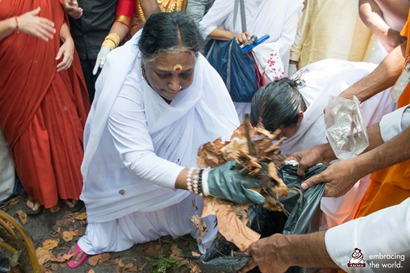
| Home | Source Reduction | Friends of Green Friends | Newsletters |
| Gardening | Resources | What You Can Do | Embracing The Trees |
| New Year's Source Reduction Resolutions | |
 Amma helps clean up the coastline near Amritapuri |
While we greet the New Year and a new decade, let us consider at least one resolution to honor Amma’s suggestions regarding Source Reduction (reducing waste at the source aside from simply recycling).
"The greatest journey begins with the smallest step. Let each one of us welcome the New Year by making small changes in our life. If we are all able to do that, then will be able to usher in a new age of love, compassion and selflessness." - from Amma’s 2013 New Year’s message A few ways in which we can reduce our consumption of the precious resources of our Mother Earth:
|
"I made my own liquid laundry detergent because I was interested in not only reducing my environmental footprint, but also saving money. The recipe I used made approximately 5 gallons of laundry detergent. I stored the detergent in a 5 gallon bucket that could be reused over and over again. It cost approximately $2 - $3 to make a 5 gallon batch. For HE front loading washers, use 1/2 cup for a large load. For regular top-loading washers, use 1 cup for a large load. With these measurements, your $2 - $3 batch of laundry detergent will last you between 80 -160 large load washes! I used the detergent for all my laundry and I never noticed a difference in the washing power of my homemade detergent versus the commercially made detergent. It was a huge savings and greatly reduced my environmental footprint because I was able to use the same plastic container over and over again and the other ingredients came packaged in cardboard and paper which could be easily recycled, composted or added to a fireplace for fuel."
|
|
| Home | Source Reduction | Friends of Green Friends | Newsletters | Resources | What You Can Do | Contact Us |
For more information, e-mail info@greenfriendsna.org |
||||||